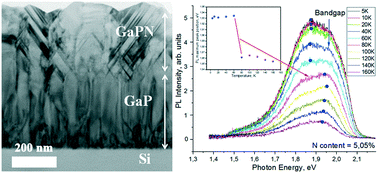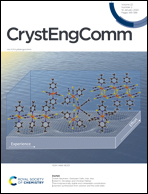Structural and optical characterization of dilute phosphide planar heterostructures with high nitrogen content on silicon†
Abstract
III–V/Si integration is one of the bottlenecks of modern semiconductor technology. Dilute nitride phosphides (III–P–N) are among the promising materials providing lattice matching with Si. In this work, we study the effect of growth conditions on the chemical composition and properties of GaP1−xNx/GaP/Si planar heterostructures synthesized by plasma assisted molecular beam epitaxy. A series of samples with a maximum fraction of incorporated nitrogen as high as 5.05% is synthesized. The morphological, structural and optical properties of the heterostructures are studied. The tendency towards 3D growth and microtwinning in dilute nitride layers are demonstrated with the increase of nitrogen content. The most intense room temperature (RT) red photoluminescence (PL) emission is obtained with the sample containing 3.07% N. The PL intensity is found to be dependent on the N growth flux while its content only slightly changes with the flux. A low temperature PL study demonstrates efficient donor–acceptor recombination in the synthesized samples. Despite low structural perfection, the sample with the highest nitrogen content demonstrates PL response at RT centered at 1.76 eV.



 Please wait while we load your content...
Please wait while we load your content...